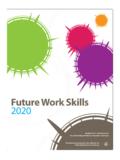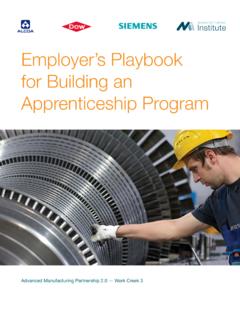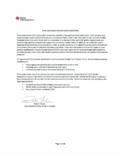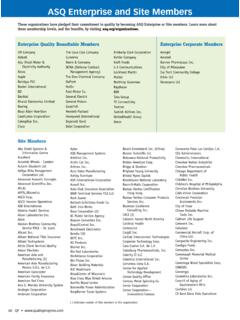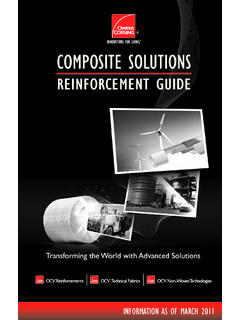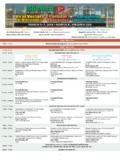Transcription of Composite Graphics The next era of human …
1 Composite Graphicspage 2 EMERGING technologies IMPACT ON SOCIETY & WORK IN 2030 The next era ofhuman|machinePARTNERSHIPSINSTITUTE FOR THE FUTURE Institute for the Future (IFTF) is an independent, nonprofit 501(c)(3) strategic research and educational organization celebrating nearly 50 years of forecasting experience. The core of our work is identifying emerging trends and discontinuities that will transform global society and the global marketplace. Our research generates the foresight needed to create insights that lead to action and spans a broad territory of deeply transformative futures, from health and health care to technology, the workplace, learning, and human identity. As an educational organization, IFTF strives to comply with fair-use standards and publish only materials in the public domain under the Creative Commons International License (CC BY-NC-ND ). The Institute for the Future is based in Palo Alto, California.
2 ( )This report was researched, written, designed, and produced by IFTF in English. With IFTF permission, the Dell technologies Globalization Team has translated the work with approved Language Service Providers (LSPs) around the world to obtain quality translation of the work, however content may differ from the original source material. All translations shall remain under the original copyright. DELL technologies Dell technologies is a unique family of businesses that provides the essential infrastructure for organizations to build their digital future, transform IT, and protect their most important asset, information. The company services customers of all sizes ranging from 98% of the Fortune 500 to individual consumers with the industry s broadest and most innovative portfolio from edge to core to cloud. Dell technologies family consists of the following brands: Dell, Dell EMC, Pivotal, RSA, SecureWorks, Virtustream, and This report would not have been possible without the substantial contributions of many collaborators, a partial list of whom includes:Julie MageeChristopher BishopSrinivasan SankarambadiSudhir SwamyEd KennedyJarl TagguegKatherine MillerDianne E.
3 DurhamAnastasia NylundCristian MalineanuEunice RomeroHester BruikmanGhanima AbdullahAmanda MaherRachel MichaudGreg VanderhorstAshley DrakeAmardeep Sodhi 2017 Institute for the Future for Dell technologies . All rights reserved. All trademarks are the property of their respective owners. SR-1940 ContentsIntroduction 1 Emerging technologies Impacting Our Lives 3 human - machine Partnerships by 2030 7 Impact on Individuals and Organizations by 2030 9 Digital Conductors Work Chasing People In-the-Moment LearningPreparing for the next Era of human - machine Partnerships 17 Skills & Traits for IndividualsSkills & Responses for Organizations Conclusion: human - machine Partnerships in 2030 21 Endnotes 23 ABOUT THIS RESEARCHIn 2017, Dell technologies partnered with the independent futures research group, Institute for the Future (IFTF), to explore the emerging technologies shaping the future of the human experience over the next decade, and the specific impacts and implications they will have on society and work.
4 To execute this, IFTF relied on its decades-long study on the future of work and technology, in-depth interviews with key stakeholders, and the opinions and ideas generated during an all-day facilitated workshop with a diverse set of experts from across the globe. Experts informing the report include: Ian Bork, CEO, Luminate HealthMing-Li Chai, Principal, Design Research & Strategy Office Envisioning, MicrosoftDevin Fidler, Research Director, Institute for the Future Eri Gentry, Research Manager, Institute for the Future Deborah Johnson, Anne Shirley Carter Olsson Professor Emeritus of Applied Ethics: Science, Technology, and Society, University of VirginiaJordan Howard, Social Good Strategist, GenYNotToshi Hoo, Director of Emerging Media Lab, Institute for the FutureJeremy Kirshbaum, Research Manager, Institute for the Future Rachel Maguire, Research Director, Institute for the FutureLauren McCarthy, Programmer, Media Artist, Assistant Professor of Design Media Arts University of California Los Angeles Adam Miner, PsyD, post-doctoral fellow Stanford Clinical Excellence Research Stanford University School of Medicine Liam Quinn, Chief Technology Officer, Sr.
5 Vice President, Sr. Fellow, Dell TechnologiesZulfikar Ramzan, Chief Technology Officer, RSA Security Tasneen Salim, Founder/Managing Director, GCON, Saudi Arabia William Senyo, Co-founder & Chief Executive Officer, Impact Hub Accra, GhanaJohn Suh, Vice President, Hyundai VenturesMark Thiele, Chief Strategy Officer, ApceraThuc Vu, Co-founder & Chief Executive Officer, OhmniLabs Norman Wang, Executive Producer, Opaque Media, Australia David Yeo, Chief Learning Architect, Kydon Group, Singapore The next Era of human - machine Partnerships 1 IntroductionAt its inception, very few people anticipated the pace at which the internet would spread across the world, or the impact it would have in remaking business and culture. And yet, as journalist Oliver Burkeman wrote in 2009, Without most of us quite noticing when it happened, the web went from being a strange new curiosity to a background condition of everyday life. 1 Today s emerging technologies also feel like strange, new curiosities.
6 Artificial Intelligence (AI), augmented and virtual reality, home robots, and cloud computing, to name only a few of the sophisticated technologies in development today, are capturing the imaginations of many. The advanced capabilities of today s emerging technologies are driving many academics, entrepreneurs, and enterprises to envision futures in which their impacts on society will be nothing short of transformative. At a recent expert workshop hosted by Dell technologies and the Institute for the Future (IFTF), participants suggested that the technologies in play over the next decade have the potential to solve some of the intractable problems that humanity has faced for so long, offer the opportunity to increase productivity [such that] all our basics needs [are taken care of], and fundamentally reframe notions of what it means to be a person. 2 Whether or not these emerging technologies will realize these ambitious possibilities is uncertain.
7 What is certain is that they will intersect and interact with powerful demographic, eco-nomic, and cultural forces to upend the conditions of everyday life and reshape how many live and work in 2030. As a result, many organizations and people will navigate unchartered waters over the next decade, unsure of what lies ahead. In Dell s Digital Transformation Index study, with 4,000 senior decision makers across the world, 45% say they are concerned about becoming obsolete in just 3-5 years, nearly half don t know what their industry will look like in just three years time, and 73% believe they need to be more digital to succeed in the future. With this in mind, we set out with 20 experts to explore how various social and technological drivers will influence the next decade and, specifically, how emerging technologies will recast our society and the way we conduct business by the year 2030. As a result, this outlook report concludes that, over the next decade, emerging technologies will underpin the formation of new human - machine partnerships that make the most of their respective complementary strengths.
8 These partnerships will enhance daily activities around the coordi-nation of resources and in-the-moment learning, which will reset expectations for work and require corporate structures to adapt to the expanding capabilities of human - machine teams. The next Era of human - machine Partnerships 3 There is no universally agreed upon determination of which technologies are considered emerging. For the purpose of this study, IFTF explored the impact that Robotics, Artificial Intelligence (AI) and machine Learning, Virtual Reality (VR) and Augmented Reality (AR), and Cloud Computing, will have on society by 2030. These technologies , enabled by significant advances in software, will underpin the formation of new human - machine decades, robots have performed activities that humans should not or do not want to do. This includes dangerous situations, repetitive tasks, or tasks that do not require special cognitive or problem-solving skills.
9 In the most advanced manufacturing sectors among Japan s carmakers, for example robots are already able to work unsupervised, around the clock, for up to 30 days without developments across science, technology, engineering, and communications have brought about what has been called the new Industrial Revolution, or second machine age, which will greatly expand robots competencies and functions. With these changes, a whole suite of jobs is being reimagined as automation displaces and disrupts human labor, the benefits of which have been well offshoring manufacturing jobs to low-cost economies can save up to 65% on labor costs, replacing human workers with robots can save up to 90% of these China is currently embarking upon an effort to fill its factories with advanced man-ufacturing robots, as workers wages rise and technology allows the industry to become more efficient. The province of Guang-dong, the heartland of Chinese manufacturing, has promised to invest $154 billion in installing robots.
10 According to a report released by PwC, more than a third of jobs could be at high risk of automation by the early 2030s and robots could take over 38% of current jobs in the next 15 Buoyed by their commercial success, the adoption of robots will extend beyond manufacturing plants and the workplace. Family robots, caregiving robots, and civic robots will all become commonplace as deep learning improves robots abilities to empathize and reason. Google recently won a patent to build worker robots with personalities. While there are certainly regulatory and legal hurdles, as well as cultural acceptance, to overcome, this introduction of robots into our personal lives will continue over the next 15 years. Emerging technologies Impacting Our Lives OhmniLabs Ohmni is an affordable telepresence, self-charging and self-repairing home INSTITUTE FOR THE FUTUREE merging technologies Impacting Our Lives (cont.)Artificial Intelligence and machine Learning Artificial Intelligence has come a long way from the days of Herbert Simon s Logic Theory machine program in 1956.

